Komitas Vardapet (1869-1935)
His Eternal Legacy Resounds From The Homeland
Armenian News Network / Groong
November 4, 2015
Travel Wire
By Ruth Bedevian
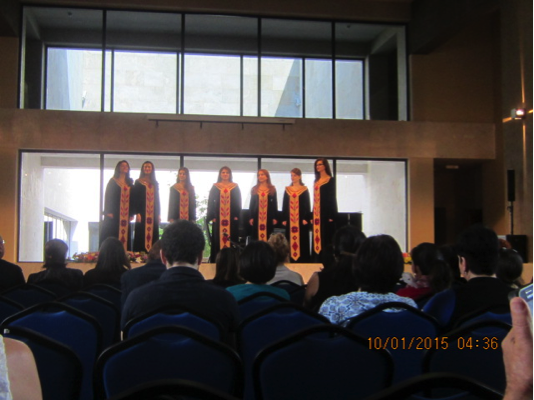
|
|
Geghard Vocal Ensemble
|
"Komitas never composed an opera, symphony, oratorio, or concerto,
yet he accomplished something much greater. He laid the
foundations of a national music culture, purifying Armenian music
of all foreign influences. Komitas has thus been rightfully
recognized as the "father of Armenian classical music." After the
Genocide, nothing was left to compile or compare, let alone
preserve for future generations; Komitas had come forward in the
11th hour to redeem a vital characteristic of a 4,000-year-old
civilization that was eventually uprooted from its cradle."
-- (Carnegie Hall Playbill - October 2008 - "Reverend Gomidas"
by Serouj Kradjian)
As our group approached the entrance to the recently established
(January 29, 2015) Komitas Museum-Institute in Yerevan, Armenia, I
immediately recalled Serouj Kradjian's poignant observation. The
museum, located in Komitas Park across from the Pantheon where
Komitas' remains were the first to be buried in 1936, truly celebrates
this 19-20th century composer, singer, ethnomusicologist, choir
conductor, and clergyman's life, talent and priceless gift to the
Armenian people and ultimately to the world. When we count from the
time of his arrival at Gevorkyan Seminary in Etchmiadzin in 1881 until
his arrest, victimization and subsequent trauma in 1915 by Turkish
authorities at the onset of the Armenian Genocide, we stand in awe at
his abundant 34-year period of prolific work which transcends the
Armenian homeland and resonates throughout the entire world of music -
a universal language that touches all hearts and souls.
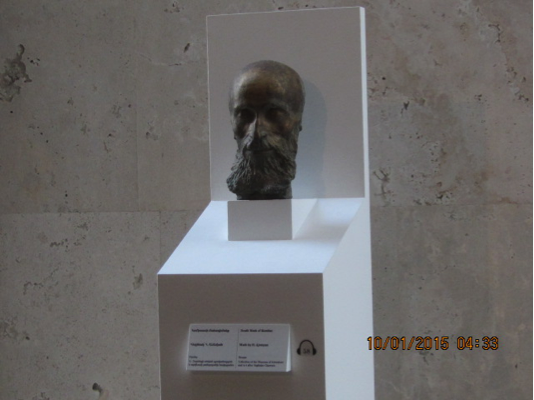
|
|
Death Mask
|
Designer/Artist Alberto Torsello and Project Coordinator Vardan
Karapetyan have created an impressive permanent collection
professionally and thematically organized that is displayed throughout
eight rooms on two stories. It contains a concert hall and enough
room to hold temporary exhibitions. The permanent memorabilia,
spaciously designed to encompass the life and work of Komitas, his
inner emotional life and music theory, also interweaves a rich
Armenian folklore heritage. Captions and wall descriptions are in
both Armenian and English languages. Technology has enhanced carefully
preserved photos from the archives of the Charents Museum of
Literature and Arts and displays them in slideshows on large flat
screens. There are photos of the teachers at Gevorkyan, choir groups
of students that Komitas taught and a moving display of photographs
from his travels throughout the rural areas where he collected and
documented ancient folk songs. After first performing concerts in the
Caucasus, he later took his choirs to Paris, Berlin, Berne, Geneva,
Venice, and other European centers, where he gave lectures and
performances. Komidas became the first non-European member of the
International Music Society of his time. An illustrated map showing
his extensive travel is digitally displayed.
Komitas graduated with a doctorate degree in musicology from the
Friedrich-Wilhelm University in Berlin (present-day Humboldt
University of Berlin - Berlin's oldest university, founded in
1810). His diploma is on display as is a handwritten one from Richard
Schmidt, with whom he studied at the conservatory. It was Schmidt who
encouraged him to both cultivate his interest in folk music and
continue his studies of Western music.
As we viewed concert programs, personal belongings and correspondence,
and art rendered to share the culture from which Komitas was bred, I
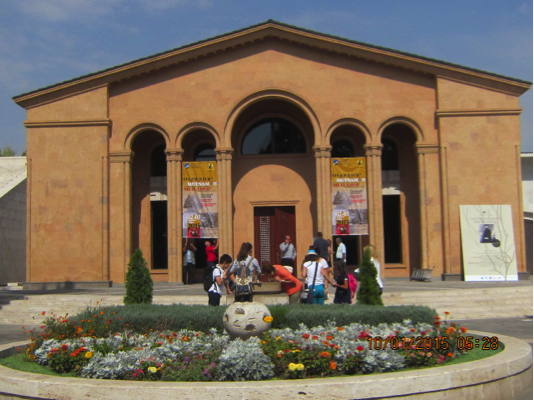
|
|
Komitas Museum-Institute
|
felt him beside me, imparting his dreams, feelings. Strains of
familiar Komitas' melodies softly enhanced the ambience. The museum
generates a genuine personal touch. Two years ago I had the privilege
to view a very small collection of memorabilia at the Charents Museum
of Literature and Arts. It was interesting, but here in this newest
museum that graces the city of Yerevan, with the sounds of his music
echoing through the halls, Komitas came alive to me!
Our guide, Nairi Khatchadourian, informed us in fluent English that
Komitas Museum-Institute participated in the European Museum of the
Year (EMF) Award 2016. "The EMF Judging Panel is looking for
enterprise and innovation that enhances the public quality of the
museum. The judges seek to identify new developments which are likely
to have a significant influence in the national and international
museum field." (http://www.europeanmuseumforum.info/emya.html) It is
impressive to know that it has been visited as recently as August 2015
by one of the jury members, Dr. Jan Gerchow, a historian from Germany
and is a possible consideration.
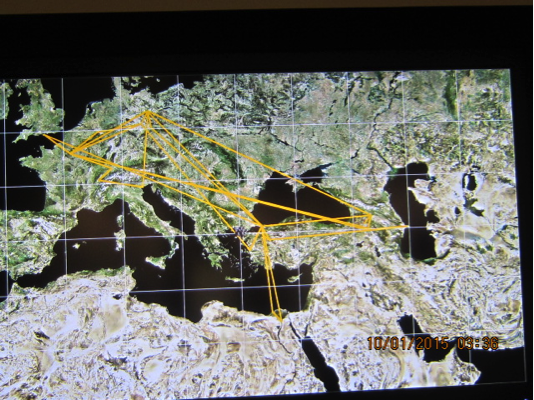
|
|
Komitas Travel Map
|
Nairi continued to inform us: "Concerts and educational programs (that
I am in charge) are regularly scheduled. The concert department has
chosen Tuesdays to schedule concerts. So every Tuesday we have
classical, sacred, or folk music concerts with local and international
artists. The concerts start at 7 pm. As for the educational programs,
we schedule them on Fridays or Saturdays at 5 pm. In October we had an
educational program on the Holy Translators Feast where we discussed
the feast and taught hymns from Mesrop Mashtots and Sahak Partev. We
have monthly lectures and Saturday singing workshops. Other workshops
include lullaby singing for couples and parents, music improvisation,
and so on."
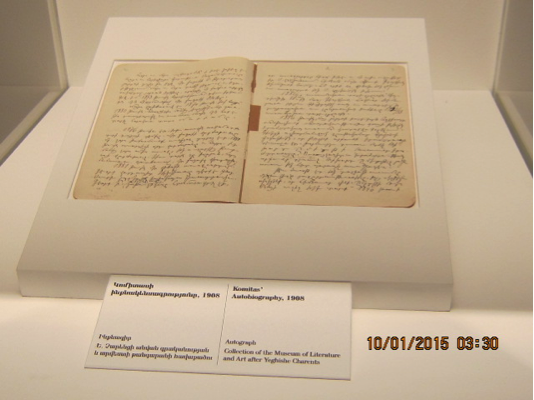
|
|
Komitas Handwritten Autobiography
|
It was a heart-warming sight to hear the chatter of school children as
groups as young as 8 years old were filing through the rooms. In
these rooms present and future generations will grow up with physical
images and opportunity to acquaint themselves with their national
heroes. No dust will cover the past for them!
Upon entering the first room, we viewed a timeline which put into
perspective Komitas' life and activity. We moved on to many displays,
including Komitas' handwritten autobiography dated 1908 and viewed his
personal flutes and the grand piano that the philanthropist, Alexander
Mantashian, gifted him. (He also underwrote his tuition for his
studies in Berlin.)
An unforgettable display of artwork by Grigor Khandjyan, illustrating
scenes from verses in Paruyr Sevak's emotive ode to Komitas, "The
Unsilenceable Belfry" (Anlreli Zangakatoun), intrigued me. A search
for an English translation was in vain, however. According to scholar,
educator and translator, Dr. Vartan Matiossian, "The poem follows
Gomidas life from his birth to his death, and intertwines it with the
historical destiny of the Armenian people." A copy of Komitas' death
mask (the original is in Venice) and a belfry suspended numerous feet
above was the last exhibit to view and tied into the theme of Paruyr
Sevak's poem.
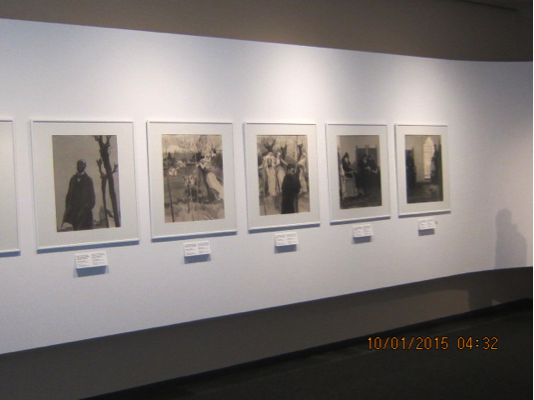
|
|
Anlreli Zangagatoun
|
In 2013, the President of Armenia Serzh Sargsyan made the decision to
establish the Komitas Museum-Institute, the Board of Trustees of the
"Hayastan" All Armenian Fund transmitted the building to the state and
by 2015 with funding from the Pyunik and Luys Foundations, the dream
was realized.
Today a state-of-the-art museum and institute emerges as a gem among
the museums of Armenia to make known to all the world the
contributions of the father of Armenian music! Our visit was
fortuitous as we caught an outstanding performance by the Geghard
Vocal Ensemble in the concert hall which was a fitting climax to the
afternoon's experience, sending us off with echoes in our hearts. The
essence of the dearly beloved Vardapet is now unveiled for visitors
from every walk of life to see, touch and feel.
The melody from the Hymn of National Blessing - Amen Hayee - which
Komitas composed as a first-year student at Gevorkyan Seminary (1891)
and whose classmate, Arshak Tashjian, created the lyrics, continues to
fill the Armenian faithful. "Hear the voice that pours forth from
every Armenian's heart, O God. Give long life to our Patriarch, long
days to the Father of the Armenians. Lord, always keep unshaken the
Mother See which you yourself have established."
--
Ruth Bedevian continues her visits in Armenia. Many of her articles are at:
http://www.groong.org/orig/armeniahousemuseums.html
Redistribution of Groong articles, such as this one, to any other
media, including but not limited to other mailing lists and Usenet
bulletin boards, is strictly prohibited without prior written
consent from
Groong's Administrator.
© Copyright 2015 Armenian News Network/Groong. All Rights Reserved.
|
| Introduction
| Administrative
| Posting Rules
| Armenian News
| World News
| Feedback
|






